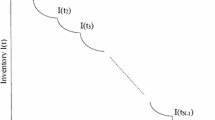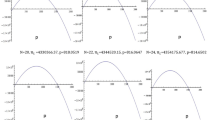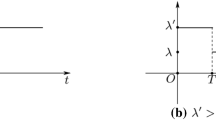Abstract
Demand and procurement planning for consumer electronics products must cope with short life cycles, limited replenishment opportunities and a willingness to pay that is influenced by past prices and decreases over time. We therefore propose the use of an integrated pricing and inventory control model with a two-period linear demand model, in which demand also depends on the difference between a price-history-based reference price and the current price. For this model we prove that the optimal joint pricing/inventory policy for the replenishment opportunity after the first period is a base-stock list-price policy. That is, stock is either replenished up to a base-stock level and a list-price is charged, or it is not replenished and a discount is given that increases with the stock-level. Furthermore, we use real-world cell phone data to study the differences between an integrated policy and traditional sequential optimization, where prices are initially optimized based on the expected demand and ordering cost, and the resulting demand distribution is used to determine an optimal inventory policy. Finally, we discuss possible extensions of the model.
Similar content being viewed by others
References
Arslan H, Kachani S (2004) Dynamic pricing under consumer reference-price effects. Wiley Encyclopedia of Operations Research and Management Science, Published Online 14 Jan 2011
Arslan H, Kachani S, Shmatov K (2009) Optimal product introduction and life cycle pricing policies for multiple product generations under competition. J Revenue Pricing Manag 8(5): 438–451
Bass F, Krishnan TY, Jain DC (1994) Why the bass model fits without decision variables. Market Sci 13(3): 203–223
Bridges E, Yim CK, Briesch R (1995) A high-tech product market share model with customer expectations. Market Sci 14(1): 61–81
Chen X, Simchi-Levi D (2004) Coordinating inventory control and pricing strategies with random demand and fixed ordering cost: the finite horizon case. Oper Res 52: 887–896
Chen Y, Ray S, Song Y (2006) Optimal pricing and inventory control policy in periodic-review systems with fixed ordering cost and lost sales. Nav Res Logist 53: 1–20
Choi TM (2007) Pre-season stocking and pricing decisions for fashion retailers with multiple information updating. Int J Prod Econ 106: 146–170
Chun YH (2003) Optimal pricing and ordering policies for perishable commodities. Eur J Oper Res 144: 68–82
Chung CS, Flynn J, Zhu J (2008) The newsvendor problem with an in-season price adjustment. Eur J Oper Res 198(1): 148–156
Eliashberg J, Steinberg R (1993) Marketing-production joint decision-making. In: Eliashberg J, Lilien GL (eds) Handbooks in operations research and management science—marketing, handbooks in operations research and management science, vol 5, chap 18. North Holland, Amsterdam, pp 827–880
Elmaghraby W, Keskinocak P (2003) Dynamic pricing in the presence of inventory considerations: research overview, current practices, and future directions. Manage Sci 49(10): 1287–1309
Eppen GD, Iyer AV (1997a) Back up agreements in fashion buying—the value of upstream flexibility. Manage Sci 43(11): 1469–1484
Eppen GD, Iyer AV (1997b) Improved fashion buying with bayesian updates. Oper Res 45(6): 805–819
Federgruen A, Heching A (1999) Combined pricing and inventory control under uncertainty. Oper Res 47(3): 454–475
Feichtinger G, Luhmer A, Sorger G (1988) Optimal price and advertising policy for a convenience goods retailer. Market Sci 7(2): 187–201
Fibich G, Gavious A, Lowengart O (2003) Explicit solutions of optimization models and differential games with nonsmooth (asymmetric) reference-price effects. Oper Res 51(5): 721–734
Fibich G, Gavious A, Lowengart O (2005) The dynamics of price elasticity of demand in the presence of reference price effects. J Acad Market Sci 33(1): 66–78
Fibich G, Gavious A, Lowengart O (2007) Optimal price promotion in the presence of asymmetric reference-price effects. Manag Decis Econ 28: 569–577
Fisher M, Rajaram K, Raman A (2001) Optimizing inventory replenishment of retail fashion products. Manuf Serv Oper Manage 3(3, Summer): 230–241
Gimpl-Heersink L (2008) Joint pricing and inventory control under reference price effects. PhD thesis, WU Wien
Gimpl-Heersink L, Rudloff C, Fleischmann M, Taudes A (2007) Integrated pricing and inventory control with reference price effects. http://idscm.wu-wien.ac.at/own_pubs/InventoryPriceReferencePriceModel.pdf
Gimpl-Heersink L, Rudloff C, Fleischmann M, Taudes A (2008) Integrating pricing and inventory control: is it worth the effort. BuR Bus Res 1(1): 106–123
Greenleaf EA (1995) The impact of reference price effects on the profitability of price promotions. Market Sci 14(1): 82–104
Kopalle PK, Lindsey-Mullikin J (2003) The impact of external reference price on consumer price expectations. J Retail 79(4): 225–237
Kopalle PK, Winer RS (1996) A dynamic model of reference price and expected quality. Market Lett 7(1): 41–52
Kopalle PK, Rao AG, Assuncao JL (1996) Asymmetric reference price effects and dynamic pricing policies. Market Sci 15(1): 60–85
Kurawarwala AA, Matsuo H (1996) Forecasting and inventory management of short life-cycle products. Oper Res 44(1): 131–150
Lee H, Lodree EJ (2010) Modeling customer impatience in a newsboy problem with time-sensitive shortages. Eur J Oper Res 205: 595–603
Lowengart O (2002) Reference price conceptualisations: an integrative framework for analysis. J Market Manag 18: 145–171
Mazumdar T, Raj S, Sinha I (2005) Reference price research: review and propositions. J Market 69: 84–102
Natter M, Reutterer T, Mild A, Taudes A (2007) An assortment-wide decision-support system for dynamic pricing and promotion planning in DIY retailing. Market Sci 26(4): 576–583
Neweklowsky M, Pein W, Moser P (2005) Siemens and t-mobile supply chain demand forecasting with the bass model. Master’s thesis, WU Wien
Petruzzi NC, Dada M (2001) Information and inventory recourse for a two-market, price setting retailer. Manuf Serv Oper Manage 3(3, Summer): 242–263
Popescu I, Wu Y (2007) Dynamic pricing strategies with reference effects. Oper Res 55(3): 413–429
Ramaswamy V, Desarbo WS, Reibstein DJ, Robinson WT (1993) An empirical pooling approach for estimating marketing mix elasticities with pims data. Market Sci 12(1): 103–124
Reiner G, Natter M (2007) An encompassing view on markdown pricing strategies: an analysis of the austrian mobile phone market. OR Spectr 29: 173–192
Sen A, Zhang AX (2009) Style goods pricing with demand learning. Eur J Oper Res 196: 1058–1075
Stadtler H (2005) Supply chain management and advanced planning—basics, overview and challenges. Eur J Oper Res 163: 575–588
Topkis DM (1987) Minimizing a submodular function on a lattice. Oper Res 26(2): 305–321
Topkis DM (1998) Supermodularity and complementarity, 10 edn. Princeton University Books, Princeton
Urban TL (2008) Coordinating pricing and inventory decisions under reference price effects. Int J Manuf Technol Manage 13(1): 78–94
Wathieu L, Bertini M (2007) Price as a stimulus to think: the case for willful overpricing. Market Sci 26(1): 118–129
Winer RS (1985) A price vector model of demand for consumer durables: preliminary developments. Market Sci 4(1): 74–90
Winer RS (1986) A reference price model of brand choice for frequently purchased products. J Consum Res 13: 250–256
Yin R, Rajaram K (2007) Joint pricing and inventory control with a Markovian demand model. Eur J Oper Res 182: 113–126
Author information
Authors and Affiliations
Corresponding author
Rights and permissions
About this article
Cite this article
Taudes, A., Rudloff, C. Integrating inventory control and a price change in the presence of reference price effects: a two-period model. Math Meth Oper Res 75, 29–65 (2012). https://doi.org/10.1007/s00186-011-0374-1
Received:
Accepted:
Published:
Issue Date:
DOI: https://doi.org/10.1007/s00186-011-0374-1




